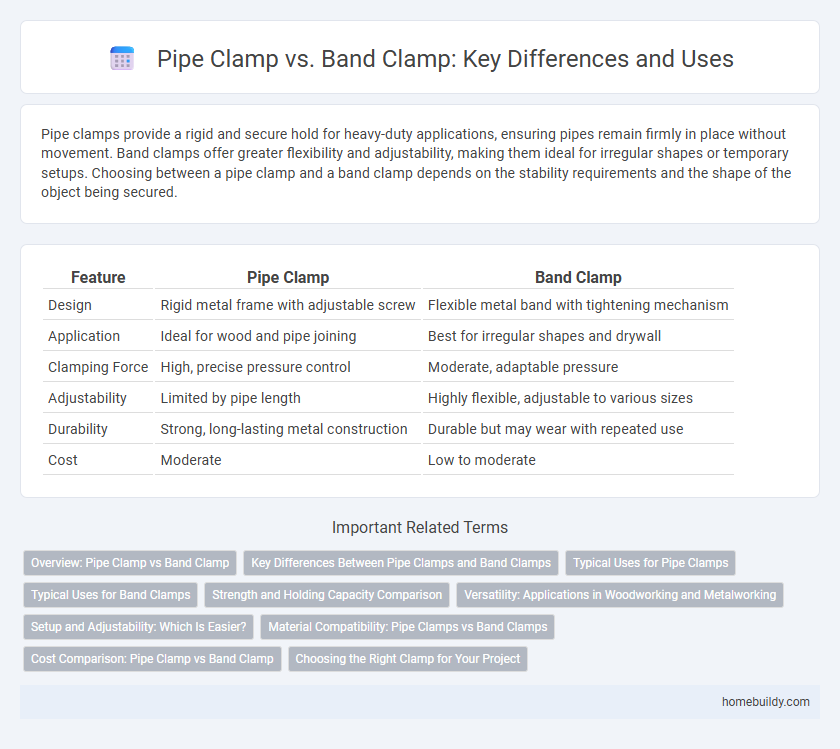Pipe clamps provide a rigid and secure hold for heavy-duty applications, ensuring pipes remain firmly in place without movement. Band clamps offer greater flexibility and adjustability, making them ideal for irregular shapes or temporary setups. Choosing between a pipe clamp and a band clamp depends on the stability requirements and the shape of the object being secured.
Table of Comparison
| Feature | Pipe Clamp | Band Clamp |
|---|---|---|
| Design | Rigid metal frame with adjustable screw | Flexible metal band with tightening mechanism |
| Application | Ideal for wood and pipe joining | Best for irregular shapes and drywall |
| Clamping Force | High, precise pressure control | Moderate, adaptable pressure |
| Adjustability | Limited by pipe length | Highly flexible, adjustable to various sizes |
| Durability | Strong, long-lasting metal construction | Durable but may wear with repeated use |
| Cost | Moderate | Low to moderate |
Overview: Pipe Clamp vs Band Clamp
Pipe clamps provide robust, rigid support by securely fastening pipes with a fixed, typically metal, frame designed for heavy-duty applications. Band clamps offer flexible, adjustable tension using a continuous strap that wraps around objects, making them ideal for irregular shapes and lighter securing needs. The choice between pipe clamps and band clamps depends on the required level of stability, material compatibility, and the specific use case environment.
Key Differences Between Pipe Clamps and Band Clamps
Pipe clamps feature a rigid frame designed to hold pipes securely during welding, plumbing, or construction, providing strong lateral support and precise alignment. Band clamps use adjustable, flexible straps that encircle irregular or multiple objects, offering versatility and ease of use for clamping round or oddly shaped materials. The primary difference lies in pipe clamps' fixed, heavy-duty structure versus band clamps' adaptable, strap-based design catering to different application needs.
Typical Uses for Pipe Clamps
Pipe clamps are typically used in woodworking and metalworking for holding pipes or cylindrical objects securely during assembly or welding. They offer strong, adjustable clamping pressure ideal for pipe fitting, plumbing, and construction tasks where precision and stability are required. Unlike band clamps, pipe clamps excel at holding irregular or heavy-duty materials tightly without slipping.
Typical Uses for Band Clamps
Band clamps are typically used for securing irregularly shaped objects or bundles, such as holding multiple pipes or cables together during transport or storage. They provide even pressure distribution around the circumference, making them ideal for temporary or adjustable fastening applications. Unlike pipe clamps, band clamps are preferred in situations requiring flexibility and adaptability to various shapes and sizes.
Strength and Holding Capacity Comparison
Pipe clamps offer superior strength and higher holding capacity compared to band clamps due to their robust construction and rigid materials, typically steel or cast iron. The design of pipe clamps allows for even distribution of pressure around the pipe, minimizing deformation and ensuring a secure fit, whereas band clamps often rely on flexible straps that can loosen under heavy loads. For applications requiring maximum durability and strong holding power, especially in plumbing or construction, pipe clamps are the preferred choice.
Versatility: Applications in Woodworking and Metalworking
Pipe clamps offer superior versatility compared to band clamps, seamlessly accommodating both woodworking and metalworking projects due to their adjustable pipe lengths and strong clamping force. In woodworking, pipe clamps excel at holding large panels and frames together, providing stability during glue-ups or assembly, while in metalworking, their robust construction and customizable size adapt to various pipe diameters, aiding in welding or fabrication tasks. Band clamps, although useful for irregular shapes, lack the precise adjustability and heavy-duty support that pipe clamps deliver across diverse applications in both crafts.
Setup and Adjustability: Which Is Easier?
Pipe clamps offer straightforward setup with a fixed frame that securely holds pipes in place, allowing for quick adjustments by tightening or loosening the screw mechanism. Band clamps provide enhanced adjustability by encircling pipes or irregular shapes, making them ideal for varying diameters but often requiring more time to position and secure properly. For tasks needing rapid, repeatable setup, pipe clamps are generally easier, while band clamps excel in versatility for non-standard shapes.
Material Compatibility: Pipe Clamps vs Band Clamps
Pipe clamps generally offer superior material compatibility, as they are often made from corrosion-resistant materials like stainless steel or galvanized steel, making them ideal for securing metal, PVC, and other common piping materials. Band clamps, typically composed of flexible metal or rubberized materials, provide greater adaptability for irregular shapes but may lack the same durability and chemical resistance required for certain industrial applications. Selecting between pipe clamps and band clamps depends heavily on the pipe material and environmental conditions to ensure long-term stability and safety.
Cost Comparison: Pipe Clamp vs Band Clamp
Pipe clamps generally offer a lower initial cost compared to band clamps, making them a budget-friendly option for many plumbing and construction projects. Band clamps, while often pricier upfront, provide enhanced durability and flexibility, potentially reducing replacement and maintenance expenses over time. Evaluating total cost of ownership, including longevity and performance, is crucial when choosing between pipe clamps and band clamps.
Choosing the Right Clamp for Your Project
Pipe clamps provide robust support for securing pipes with a firm grip and excellent load distribution, ideal for heavy-duty plumbing and construction tasks. Band clamps offer greater flexibility and can be easily adjusted for different diameters, making them suitable for temporary holds and irregular shapes. Selecting the right clamp depends on the rigidity required and pipe diameter variability in your specific project.
pipe clamp vs band clamp Infographic

 homebuildy.com
homebuildy.com